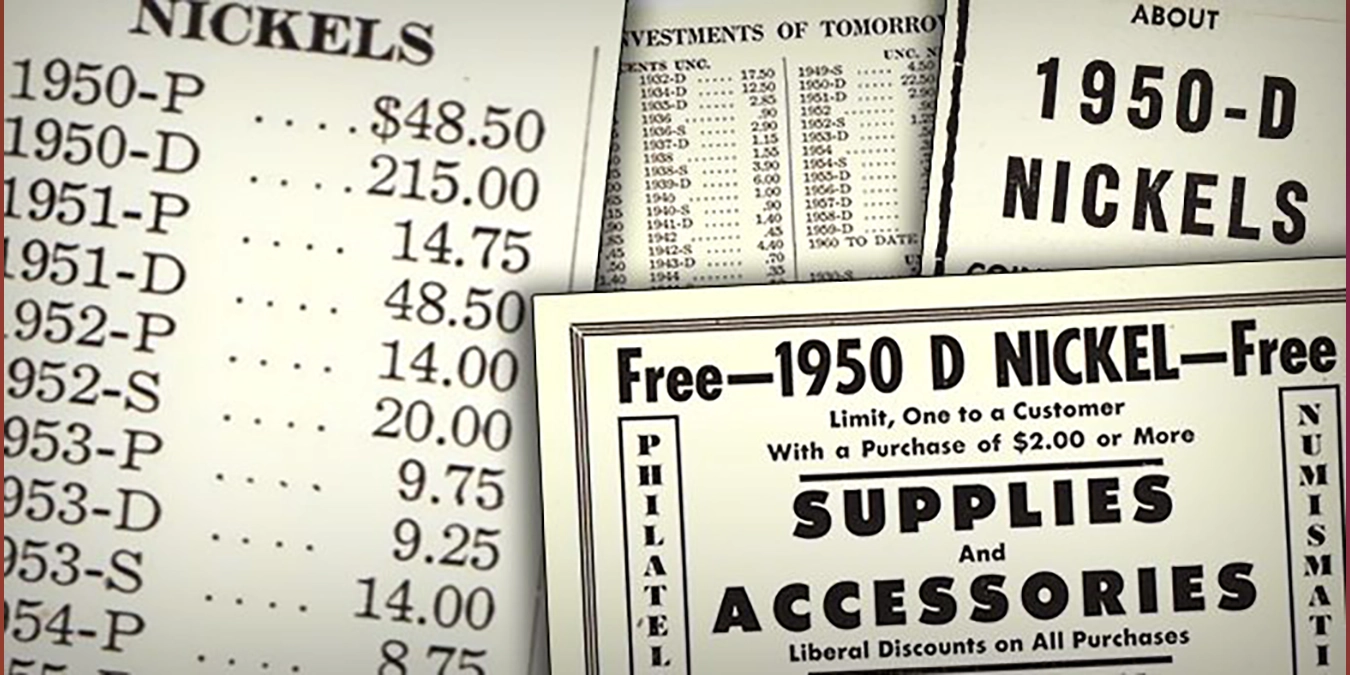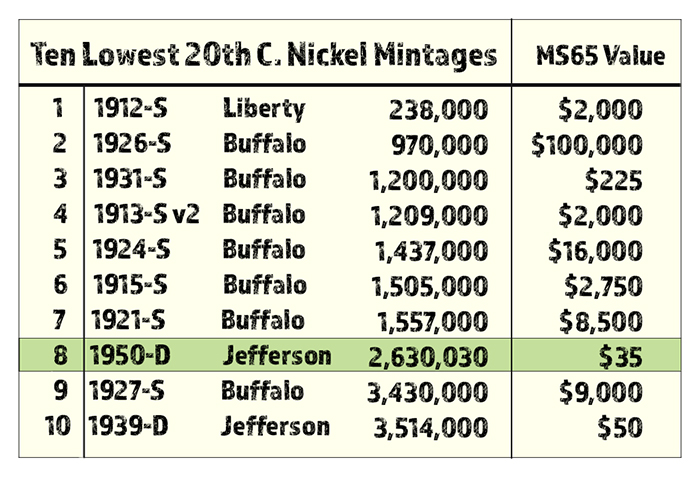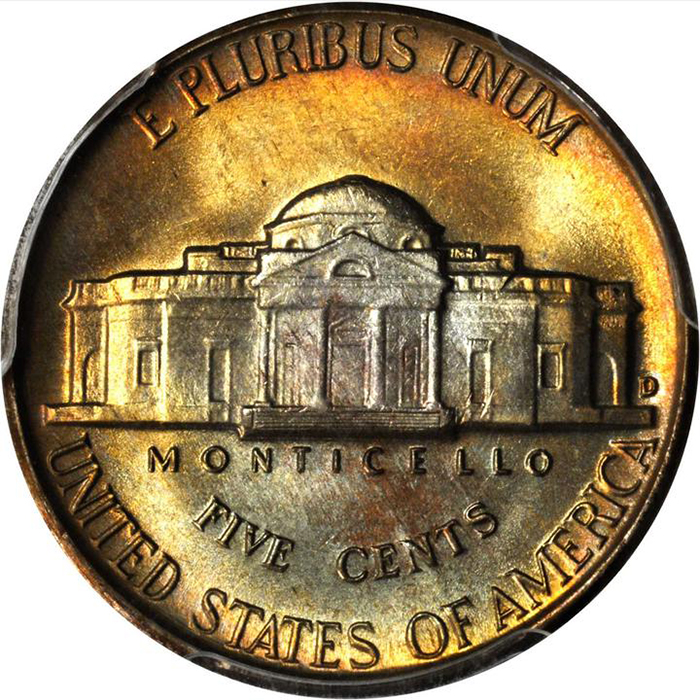
The 1950-D Jefferson Nickel Was Promoted as a Key-Date Coin
2,630,030 Jefferson nickels were struck at the Denver Mint in 1950, a coinage that was carried out without the expectation of much in the way of public notice. Demand for the new nickel coins in the areas serviced by the Denver Mint was low in this particular year as the American economy was mired in the third year of a post-war recession. The mintage of preceding years was sufficient for most of the year. Because of this, orders for new nickel coinage for the Denver Mint did not come in until summer, and upon delivery, no new coins were ordered for the remainder of the calendar year.

The general public only became aware of this low mintage and the coin’s potential as a collectible and investment item due to the tireless work of coin promoters. Many of these promoters were new to the coin industry, but saw the 1950-D nickel as a means to capitalize on the public’s desire to make a quick buck. As a result, the 1950-D nickel was heavily hoarded, marketed, and promoted… and for years the issue traded freely as a modern “rarity”.
Interest in the coin, which was broad and mainstream, focused new enthusiasm for the collecting of modern coins and brought with it the era of roll collecting and investing.

By the late 1960s, ads in The Numismatist and other numismatic publications offered single examples of the 1950-D for prices approaching $20 per coin. No other coin in the modern series elicited as much excitement about the investment potential as did the 1950-D. The issue served as a model, however, for what other rolls were “worth” to speculators. The investment was premised around the idea that future collectors would come into the market and require past issues for their National or Whitman coin boards and albums.
What developed was a bubble and a marketplace that could not sustain itself, at least not as an investment. Thousands of bags of 1950-D nickels were hoarded by marketers and much of the mintage of the summer of 1950 was forever taken out of circulation.
Today, it is far more unusual to find an example in circulated condition and even rarer to find one still in circulation than it is to find a nice example in choice or gem grades. As a result, the typical gem might sell for $30-$40, if certified by PCGS or NGC.
Mintages Alone Do Not Determine Key Dates
For good and bad, the 1950-D will never shed its notorious reputation as a heavily-hoarded and heavily-promoted coin. For Jefferson nickel collectors, even casual ones, the 1950-D will cost a tidy premium, but is essential for the completion of a full set. Series specialists know that there are far more interesting and much more scarce issues in the series, especially when Full Steps designation and conditional rarity come into play. Still, the 1950-D stands as a helpful lesson in the difference between numismatic fact and numismatic innuendo.
The general public and a whole generation of collectors were led to believe that this was the key date of the Jefferson nickel series. When one thinks of 20th century key dates in the non-gold series, one thinks of the 1909-S VDB cent, the 1916 Mercury dime, and the 1916 Standing Liberty quarter, to name a few. Some of these coins are truly scarce, while others are scarce relative to demand. The 1950-D has neither of these characteristics, but that fact and its history as a heavily promoted coin gives it some charm. And charm is what makes coins so much fun!
How Can I Tell if My 1950-D Nickel Has Full Steps?
Of course, Full Steps nickels are about four times rarer than their non-designated uncirculated counterparts. The following graphic provides an easy to understand visual reference on the Full Steps designation.

In this graphic you see that the steps, located on the design between the stylobate, a flat pavement section on which rest the four front columns of the design, and the foundation block at the base of the steps. Factors such as die condition, striking pressure, and incidental contact with other coins, play a significant factor in whether a Jefferson nickel will earn the Full Steps designation.
Design
Obverse:
A left-facing bust of President Thomas Jefferson, including a colonial-era pigtail and strikingly similar in detail to the profile of Jean-Antoine Houdon’s 1789 bust, takes up the majority of the obverse. The top of his head almost touches the rim, and the barest of truncations is visible at the bottom where Jefferson’s left shoulder meets the edge of the coin. The motto IN GOD WE TRUST–which became the national motto in 1956–arcs clockwise along most of the length of the left side of the coin, starting from Jefferson’s chest and extending to his hairline. The inscriptions LIBERTY and the date 1950 run clockwise along the right side behind Jefferson. A small five-pointed star divides the two inscriptions

Reverse:
The reverse features a front view of Monticello, Jefferson’s mansion near Charlottesville, Virginia. The polymath Jefferson designed the neoclassical building himself, based on architectural principles from the Italian Renaissance; the name “Monticello” comes from the Italian for “mound” or “little mountain”. The building loses much of its dimensionality in the flattened rendering, but the octagonal nature of the dome can still be interpreted, and better strikes reveal significant detail in the steps and portico.
Atop the reverse is the motto E PLURIBUS UNUM (“Out of Many, One”). The name MONTICELLO–the placement of which on the coin was one of the revisions forced upon Schlag by the Mint–is found in a straight line immediately under the building; the positions and spacing of the other inscriptions had to be adjusted to make room for it. The denomination FIVE CENTS forms a gently curving line beneath that, and the inscription UNITED STATES OF AMERICA runs counterclockwise along the bottom edge of the coin. A small mint mark “D” is found to the far right of the mansion.
Interestingly, Felix Schlag’s initials did not appear on a Jefferson nickel until 1966.
Edge:
The edge of the 1950-D Jefferson nickel is plain or smooth, without reeding or edge lettering.
Designer
Felix Schlag was born in Frankfurt, Germany in 1891. After receiving an education at the Munich University of Fine Arts, he moved to the United States in 1929. Schlag died in 1974. Yet while he did win numerous art contests and commissions throughout much of the remainder of his life, the Jefferson Nickel was his only coin design.
Coin Specifications
| Country: | United States of America |
| Year Of Issue: | 1950 |
| Denomination: | Five Cents (USD) |
| Mint Mark: | D (Denver) |
| Mintage: | 2,630,030 |
| Alloy: | 75% Copper, 25% Nickel |
| Weight: | 5.00 grams |
| Diameter: | 21.21 mm |
| Edge: | Plain |
| OBV Designer | Felix Schlag |
| REV Designer | Felix Schlag |
| Quality: | Uncirculated |
* * *





I really appreciate the help of a long coming, and overdue list suchlike this. I’ve just read. However. I’ve just become one of history’s unexpected victims in the counterfeit scam to say the I’ve encountered some verrious Morgan dollars recently that do not pass the good old magnet . I’m fortunately not in to them for more than a song, but could use a list of more common fakes in the dollar coine .thanks for any consideration.
I expect the 1950-D nickel to continue to lose value. If the actual current market value for a “gem” is $30 to $40, it is relatively overpriced for such as incredibly common coin.
The “key” dates mentioned in this article aren’t remotely scarce or rare either. All three mentioned (1909-S VDB cent, 1916-D dime and 1916 SLQ) are from about a dozen or slightly more common 20th century “key” dates which are among the most overpriced even among US coinage for the relative merits. Anyone who wants to buy these coins in multiple can easily do so at any time, except when applying some narrow or arbitrary criteria.
Hey I have a 1950 d nickle and I would like to sell it it’s like a mint state 67 or better with full steps if anyone knows we’re I can sell it thank you and God bless you all in the world
I’ve found (2) 1950 D’s while coin roll hunting over the past 2 years. Even though they have a lot of wear, I’m not selling them. They’re just too hard to find.
I bought a counterfeit 1950-D Jefferson from a disreputable coin dealer who advertised in the newspaper. Tried to sell it many years later to a different dealer and he showed me how he knew it was counterfeit. I sold it to him at a loss, to use as an example for future customers. Are there a lot of counterfeit examples of this coin around?
What if I have. One
If you’ve read the full article, it states that the coins’ values have dropped significantly due to the number of high-end specimens that were saved (i.e. hoarded!). It explains that in today’s market, a gem specimen _with certification_ will only retail for $30 to $40. Of course the buying price will be less.
You might try having it examined by a dealer or shop it around at a local coin show, but based on the figures given in the article you’ll only get a price in the low double-digits, unfortunately.
You are going to get screwed on anything and everything if you do not know about the item. Have had it to happen to me to. Its not going to stop.
So Kenneth what did you do. I’m not an expert and been saving all coins I see have value, where should I go. Diana
Love the Jefferson nickel series from 1938 to 2003. I have been collecting for years and in all honesty the Jefferson nickels are WAY harder to find with full steps than to find dimes with full bands. I’ve had 6 dimes graded with full bands, only 1 nickel with full steps that being the 1991 D. Good thing about this series is you can still find almost every single year through pocket change or coin roll hunting. You can’t say that about the other denominations. PS…..I don’t know if people know this but you can get silver coins (dimes mostly) in coinstars. People pump in the silver dimes not knowing the weight is different than clad and coinstars spit them out. They leave them in the tray! i’ve personally found 6 silver dimes that way. The 1938 S, 1939 D and 1950 D are always hard to find and in demand. You can almost add the 2009 P & D to those other dates. Supply and demand…….
I like the Jefferson Nickels myself. It’s definitely an underrated series if you ask me. Full steps are hardest to find that’s a fact